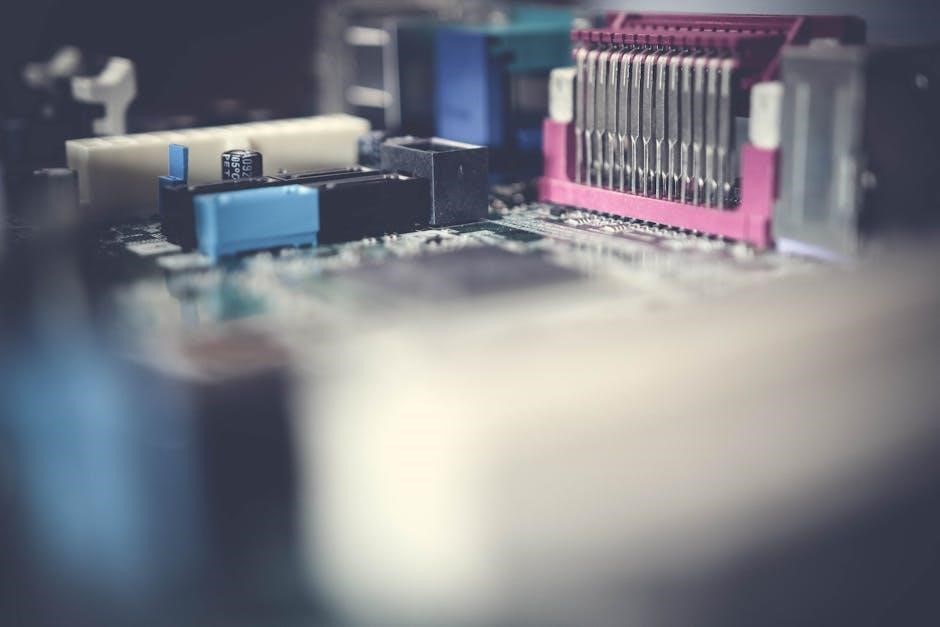on grid solar system wiring diagram pdf
An on-grid solar system connects directly to the electricity grid‚ enabling homes and businesses to reduce energy costs and carbon emissions․ These systems use solar panels‚ inverters‚ and grid ties to supply power․
A wiring diagram is essential for safe and efficient installation‚ detailing connections between components like panels‚ inverters‚ and the grid․ It ensures compliance with local electrical codes and standards․
1․1 What is an On-Grid Solar System?
An on-grid solar system is a photovoltaic (PV) system connected to the utility grid‚ allowing homes or businesses to generate clean energy while remaining tied to the electrical grid․ It uses solar panels to convert sunlight into electricity‚ which is then inverted to match grid requirements․ Excess energy is fed back into the grid‚ often earning credits‚ while the system draws power when solar generation is insufficient․ This setup eliminates the need for batteries‚ making it a cost-effective and efficient way to reduce electricity bills and carbon footprint․
1․2 Benefits of On-Grid Solar Systems
On-grid solar systems offer significant financial and environmental benefits․ They reduce electricity bills by harnessing solar energy‚ lowering reliance on utility grids․ Excess energy is fed back‚ earning credits․
These systems are environmentally friendly‚ reducing carbon emissions․ They require no batteries‚ lowering costs and maintenance․ Compliance with local codes ensures safety and efficiency‚ making them a reliable choice for sustainable energy solutions․
1․3 Importance of Wiring Diagrams in Solar Installations
Wiring diagrams are crucial for solar installations‚ providing a clear visual guide for connecting components․ They ensure safety‚ efficiency‚ and compliance with electrical standards‚ reducing risks of errors or hazards during setup and operation․
These diagrams detail connections between panels‚ inverters‚ and the grid‚ simplifying the installation process․ Proper wiring ensures optimal performance‚ preventing system failures and guaranteeing long-term reliability․ They are essential for both installers and maintenance personnel to understand and manage the system effectively․
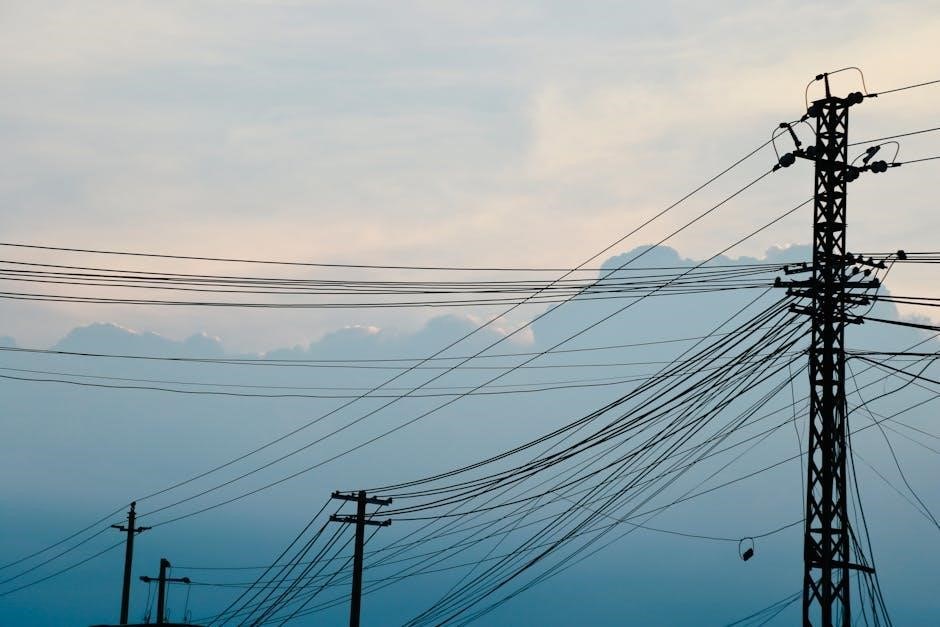
Understanding the Wiring Diagram for On-Grid Solar Systems
A wiring diagram is a visual guide showing connections between solar panels‚ inverters‚ and the grid․ It ensures safe‚ efficient installation and operation of the system․
2․1 Key Components of an On-Grid Solar System
An on-grid solar system consists of solar panels‚ inverters‚ mounting structures‚ and electrical connections․ Solar panels generate DC power‚ which inverters convert to AC for grid use․ Mounting structures ensure panels are securely installed at optimal angles․ Electrical connections‚ including wiring and circuit breakers‚ safely transmit power to the grid․ Monitoring systems track performance‚ while surge protectors and disconnects enhance safety․ These components work together to provide efficient‚ reliable energy production and grid synchronization‚ ensuring compliance with local electrical standards and regulations․
2․2 Schematic Representation of the System
A schematic diagram illustrates the on-grid solar system’s electrical connections‚ showing solar panels‚ inverters‚ circuit breakers‚ and grid ties․ Symbols represent components‚ with lines indicating wiring paths․ The diagram outlines DC power flow from panels to inverters‚ converted to AC for grid synchronization; Labels clarify connections‚ ensuring safe installation․ Color-coded lines differentiate between DC and AC circuits․ This visual guide helps installers understand system layout‚ ensuring compliance with electrical standards and efficient energy production․
2․3 Single Line Diagram for a 5×25 kW Photovoltaic System
A single line diagram for a 5×25 kW photovoltaic system simplifies the electrical connections‚ showing solar panels‚ inverters‚ and grid ties․ It uses symbols to represent components‚ with lines indicating energy flow․ The diagram highlights 340 solar panels connected in 18 series strings‚ linked to 4 MPPT inputs on each of the 5 inverters․ This configuration ensures efficient energy production and grid synchronization․ The diagram also outlines AC and DC connections‚ circuit breakers‚ and grounding points‚ ensuring compliance with safety standards like IEC 60364․

Components of an On-Grid Solar System
An on-grid solar system includes solar panels‚ inverters‚ mounting structures‚ and electrical connections․ These components work together to convert sunlight into usable electricity and feed excess power back to the grid․
3․1 Solar Panels and Their Configuration
Solar panels are the heart of an on-grid system‚ converting sunlight into electricity․ They are typically configured in series or parallel to achieve desired voltage and current levels․ For example‚ an 800W system might use 4 panels in series‚ while larger systems‚ like a 5×25 kW setup‚ use 340 panels in 18 series strings․ Proper configuration ensures maximum efficiency and compatibility with inverters․ The wiring diagram illustrates these connections‚ showing how panels are grouped and linked to optimize energy production․ This setup ensures reliable power generation and grid synchronization․ Mounting structures also play a critical role in panel orientation and energy capture․
3․2 Inverters and Their Role in Grid-Tied Systems
Inverters are crucial in grid-tied systems‚ converting DC power from solar panels to AC for grid synchronization; They regulate voltage‚ frequency‚ and phase to match grid requirements․ Modern inverters‚ like those in 5×25 kW systems‚ often have multiple MPPT inputs for efficient energy harvesting․ The wiring diagram details connections between panels‚ inverters‚ and the grid‚ ensuring safe and efficient energy flow․ Inverters also provide real-time monitoring and grid feedback‚ optimizing system performance and enabling seamless integration with utility power․ Proper inverter configuration is vital for reliability and compliance with grid standards․
3․3 Mounting Structures and Electrical Connections
Metal mounting structures secure solar panels‚ ensuring optimal angle and orientation for maximum energy capture․ Electrical connections involve wiring between panels‚ inverters‚ and the grid․ The wiring diagram specifies connections for series and parallel configurations‚ such as 18 series strings in a 5×25 kW system․ Proper grounding and insulation are critical for safety․ Compliance with regional electrical codes‚ like those in Australia and the USA‚ ensures reliable and efficient energy distribution․ Secure connections prevent power loss and ensure long-term system performance․
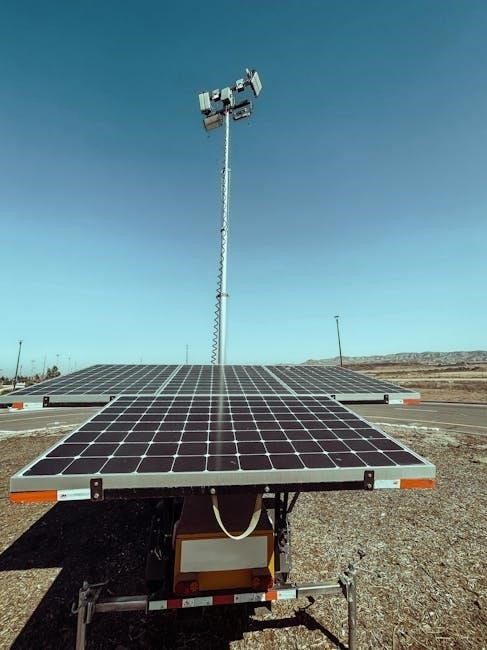
Step-by-Step Guide to Wiring an On-Grid Solar System
Start by preparing components‚ then connect panels in series or parallel․ Install the inverter‚ ensuring grid synchronization․ Finally‚ secure all connections and test the system for efficiency and safety․
4․1 Preparing the System Components
Preparing the system components involves verifying compatibility and ratings of solar panels‚ inverters‚ and mounting structures․ Ensure all components are certified and meet local standards․ Organize tools like wire cutters‚ connectors‚ and safety gear․ Review the wiring diagram to understand connections․ Check for damaged parts and replace if necessary․ Properly label cables and wires for clarity․ Confirm the inverter’s grid synchronization settings and battery configurations if applicable․ Ensure electrical connections comply with regional codes for safety and efficiency․ This step ensures a smooth installation process․
4․2 Connecting Solar Panels in Series and Parallel
Connecting solar panels in series increases voltage‚ while parallel connections boost current․ Use a wiring diagram to determine the optimal configuration for your system․ Series connections require matching panel ratings to avoid underperformance․ Parallel connections reduce voltage demands but increase current‚ needing heavier wires․ Ensure all connections are secure and weatherproof․ Use MC4 connectors for compatibility and safety․ Properly label each string for easy referencing․ Follow the diagram to connect strings to the inverter’s MPPT inputs‚ ensuring correct polarity․ This configuration maximizes energy output and system efficiency while adhering to safety standards․
4․3 Installing the Inverter and Grid Connection
Mount the inverter near the electrical panel‚ ensuring easy access․ Connect the solar array to the inverter’s DC input terminals‚ following the wiring diagram․ Secure all wires with appropriate connectors․ Next‚ link the inverter’s AC output to the grid connection point‚ typically near the main circuit breaker․ Ensure the system is grounded and meets local electrical codes․ Test the inverter’s communication with the grid and verify power export settings․ Finally‚ activate the system and monitor its performance through the inverter’s display or remote monitoring app․
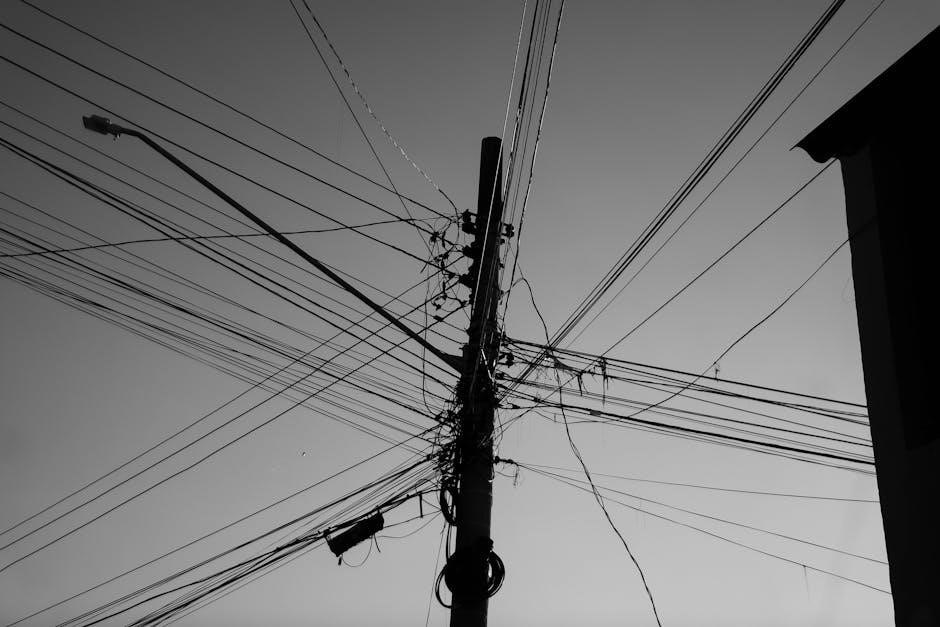
Regional Standards and Regulations
Ensure compliance with local electrical codes and grid connection standards․ Adhere to regional regulations in Australia‚ New Zealand‚ and the USA for safe and reliable solar installations․
5․1 Compliance with Local Electrical Codes
Compliance with local electrical codes is crucial for safety and legal requirements․ Ensure all wiring and installations meet national standards‚ such as AS/NZS 5033 in Australia and NEC 690 in the USA․ Proper permitting and inspections are necessary to avoid fines or system rejection․ Use certified components and follow guidelines for grid connection‚ grounding‚ and overcurrent protection․ A detailed wiring diagram specific to your region will help ensure adherence to these regulations‚ preventing potential hazards and ensuring efficient system operation․ Always consult local authorities or licensed electricians for compliance verification․
5․2 Standards in Australia‚ New Zealand‚ and the USA
In Australia and New Zealand‚ solar installations must comply with AS/NZS 5033‚ covering safety‚ design‚ and installation․ The USA adheres to NEC 690‚ outlining requirements for PV systems․ Both standards ensure safe grid integration‚ proper grounding‚ and overcurrent protection․ Local authorities enforce these regulations to prevent hazards and ensure system reliability․ Compliance involves using certified components and following specific wiring guidelines․ A wiring diagram aligned with these standards simplifies adherence‚ ensuring installations meet legal and safety requirements in each region‚ thus protecting both users and the grid infrastructure from potential risks and inefficiencies․
5․3 Safety Precautions and Best Practices
Ensuring safety during solar system installation is paramount․ Always disconnect power before working on components․ Use protective gear like gloves and safety glasses․ Follow the wiring diagram precisely to avoid short circuits and ensure proper connections․ Regular inspections and maintenance are crucial to maintain efficiency and safety․ Adhere to local electrical codes and manufacturer guidelines for inverters and panels․ Proper grounding and bonding prevent electrical hazards․ Keep emergency contact information accessible and ensure all personnel are trained in solar system operations and emergency procedures to maintain a safe working environment and reliable system performance․ Regular updates and compliance checks are essential for long-term safety and efficiency․

Advanced Configurations and Monitoring
Advanced configurations include microinverters and energy monitoring systems‚ enabling real-time tracking of solar production and grid interaction through Bluetooth and mobile apps for optimal performance and control․
6․1 Microinverter Systems and Their Wiring
Microinverter systems optimize energy production by converting DC power to AC at each solar panel‚ reducing losses and enhancing efficiency․ The wiring involves connecting each microinverter directly to a panel‚ forming a decentralized configuration․ This setup simplifies installation and monitoring‚ allowing individual panel performance tracking․ The system integrates seamlessly with the grid‚ ensuring safe and efficient energy distribution․ Detailed wiring diagrams for microinverters are available‚ guiding installers through connections and ensuring compliance with electrical standards for reliable operation and scalability․
6․2 Bluetooth Monitoring and Mobile App Integration
Bluetooth monitoring and mobile app integration enable real-time tracking of solar system performance․ Users can monitor energy production‚ consumption‚ and grid feed-in through intuitive apps․ These tools provide detailed analytics‚ alerts for system issues‚ and remote troubleshooting․ Bluetooth connectivity ensures seamless communication between inverters‚ charge controllers‚ and mobile devices․ Apps like those for microinverters offer panel-level monitoring‚ optimizing energy efficiency․ This technology enhances user experience‚ simplifies system management‚ and ensures optimal performance․ Detailed wiring diagrams support integration‚ ensuring reliable communication and data accuracy for grid-tied systems․
6․3 Grid-Tied Systems with Battery Backup
Grid-tied systems with battery backup combine solar energy storage and grid connectivity․ These systems allow excess solar power to charge batteries for later use‚ even during grid outages․ The wiring diagram illustrates connections between solar panels‚ inverters‚ batteries‚ and the grid․ It ensures seamless energy flow‚ prioritizing solar power and storing excess energy․ Battery backup enhances energy independence and reliability․ The diagram details how batteries integrate with inverters and grid ties‚ ensuring safe and efficient operation․ This setup is ideal for locations with frequent power outages‚ providing continuous energy supply while maintaining grid connectivity․
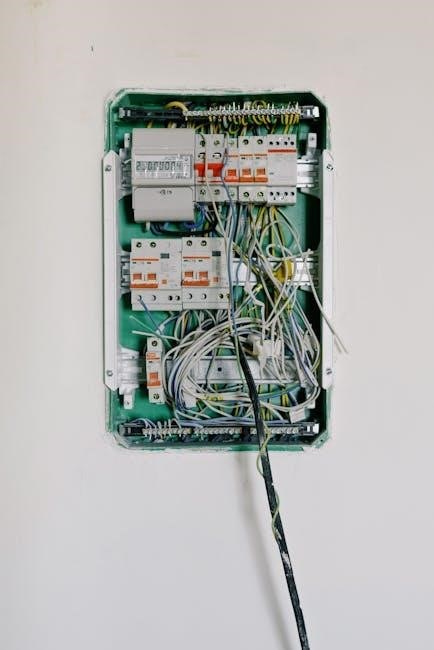
Wiring Diagrams for Specific System Sizes
Wiring diagrams are tailored to specific system sizes‚ ensuring safe and efficient connections․ They provide detailed layouts for 800W‚ 2kW‚ and larger systems like 7‚200W setups‚ offering scalability and precision․
7․1 800W Solar Panel Wiring Diagram
An 800W solar panel wiring diagram provides a clear guide for installing small-scale systems․ It includes a detailed layout of solar panels‚ inverters‚ and electrical connections․ The diagram shows how panels are connected in series or parallel to achieve desired voltage and current․ It also outlines the integration of charge controllers and batteries for energy storage․ This setup is ideal for small homes or RVs‚ ensuring efficient energy generation․ The wiring diagram emphasizes safety and compliance with local electrical codes‚ making it a valuable resource for DIY enthusiasts and professionals alike․
7․2 2kW Off-Grid Solar Power Station Wiring
A 2kW off-grid solar power station wiring diagram illustrates the configuration for standalone systems․ It typically includes solar panels‚ a charge controller‚ battery bank‚ and inverter․ The diagram shows how panels are connected in series or parallel to optimize energy output․ The charge controller regulates power flow to the batteries‚ while the inverter converts stored energy for home use․ This setup is ideal for remote locations without grid access‚ ensuring reliable power supply․ The wiring diagram also highlights safety features and best practices for installation and maintenance․
7․3 Detailed Hi-Res PDF for 7‚200W Systems
A detailed hi-res PDF for a 7‚200W solar system provides a comprehensive guide for wiring and installation․ This document includes precise diagrams and technical specifications for an off-grid setup‚ showcasing the entire system layout․ It covers solar panels‚ inverters‚ battery banks‚ and electrical connections‚ ensuring safe and efficient power supply․ The PDF is designed for homeowners and installers‚ offering a clear visual representation of the wiring process․ This resource is ideal for those aiming to power entire homes or large-scale installations with renewable energy․

Troubleshooting and Maintenance
Troubleshooting involves identifying and resolving issues like connectivity faults or low efficiency․ Regular maintenance ensures long-term performance and safety‚ preventing potential hazards and optimizing energy output․
8․1 Common Issues in On-Grid Systems
Common issues in on-grid solar systems include connectivity faults‚ low energy efficiency‚ and inverter malfunctions․ Wiring diagram mismatches can cause system shutdowns or reduced performance․ Faulty connections or damaged components may lead to power losses․ Monitoring systems can detect issues early‚ ensuring prompt resolutions․ Regular checks of inverters‚ panels‚ and wiring are crucial for maintaining efficiency and safety․ Addressing these issues promptly prevents long-term damage and ensures optimal energy production․ Proper installation and adherence to wiring diagrams minimize such problems‚ ensuring reliable grid-tied operations․
8․2 Tools and Techniques for System Maintenance

Proper tools and techniques are essential for maintaining on-grid solar systems․ Multimeters‚ thermal cameras‚ and circuit testers help diagnose faults․ Use diagnostic software to monitor performance and detect issues early․ Regularly inspect wiring and connections as per the wiring diagram․ Clean solar panels to ensure maximum efficiency․ Follow safety protocols‚ such as disconnecting power before servicing․ Documenting maintenance activities helps track system health․ Training and certification programs can enhance technical skills for effective system upkeep․ These practices ensure long-term reliability and optimal performance of the on-grid solar system․
8․3 Ensuring Long-Term Efficiency and Safety
Regular inspections and maintenance are crucial for ensuring long-term efficiency and safety in on-grid solar systems․ Monitoring system performance through software helps detect issues early․ Compliance with local electrical codes and standards is essential for safe operation․ Proper wiring‚ as detailed in the wiring diagram‚ prevents electrical hazards․ Regular cleaning of solar panels and inverters ensures optimal performance․ Training and certification programs for technicians enhance safety and efficiency․ These practices collectively ensure the system operates reliably and safely over its lifetime․
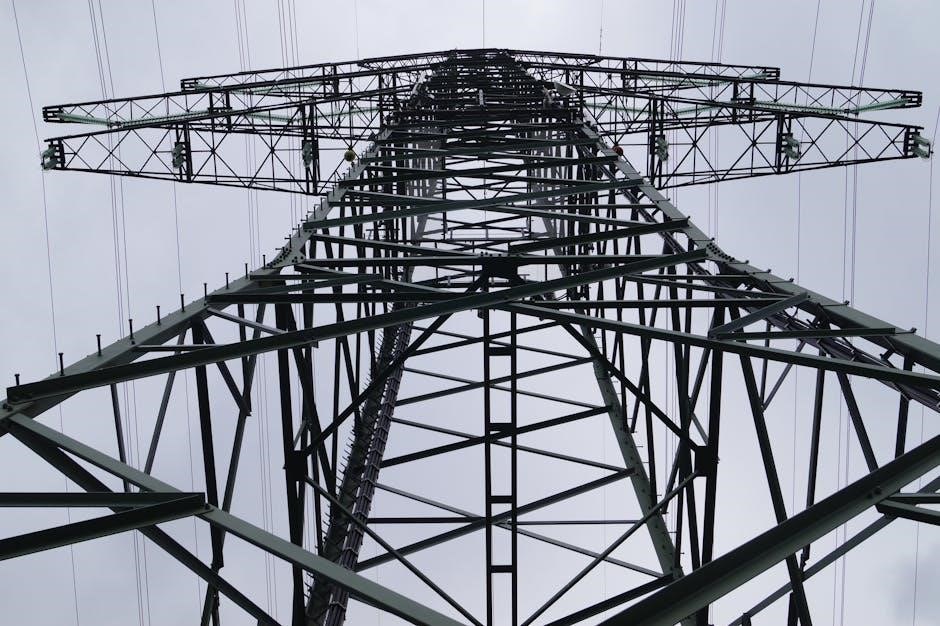
Resources for Further Learning
Download free PDF guides for on-grid solar wiring diagrams and explore tools like Schneider Electric’s Conext Designer for system design and planning․
9․1 Free Downloadable PDF Guides
Free downloadable PDF guides provide comprehensive details for on-grid solar system wiring‚ including diagrams and step-by-step instructions․ These resources are ideal for DIY installations and professional use‚ offering clear schematics and component lists․ PDFs often cover specific system sizes‚ such as 5×25 kW or 7‚200W setups‚ ensuring compatibility with various configurations․ Many guides include tools like Schneider Electric’s Conext Designer for advanced system planning․ Download these PDFs to access detailed wiring diagrams‚ safety protocols‚ and best practices for efficient solar installations․
9․2 Software Tools for System Design
Software tools like Schneider Electric’s Conext Designer simplify the planning and design of on-grid solar systems․ These tools allow users to calculate system parameters‚ optimize layouts‚ and generate detailed wiring diagrams․ They provide simulations and performance predictions‚ ensuring efficient and safe installations․ Many platforms offer customizable templates for various system sizes‚ from residential to commercial setups․ These tools are essential for professionals and DIY enthusiasts‚ streamlining the design process and ensuring compliance with electrical standards․ Utilize these resources to create accurate and reliable system designs․
9․3 Online Communities and Forums
Online communities and forums are valuable resources for discussing on-grid solar systems and sharing wiring diagrams․ Platforms like Pinterest and specialized solar forums offer extensive libraries of diagrams and guides․ Users can engage with professionals‚ share experiences‚ and troubleshoot issues․ Many communities provide free downloadable resources‚ including detailed wiring schematics for various system sizes․ These spaces foster collaboration and innovation‚ helping installers and DIY enthusiasts achieve efficient and safe solar installations․ Engaging with these communities can enhance your understanding and implementation of on-grid solar wiring systems․
An on-grid solar system wiring diagram is crucial for safe and efficient installations․ It ensures compliance with standards‚ optimizes energy use‚ and supports sustainable power solutions effectively․
10․1 Summary of Key Points
On-grid solar systems efficiently integrate with the electricity grid‚ reducing energy costs and carbon emissions․ Key components include solar panels‚ inverters‚ and mounting structures‚ connected via detailed wiring diagrams․ Compliance with regional standards in Australia‚ New Zealand‚ and the USA ensures safety and efficiency․ Tools like Conext Designer aid in system design‚ while monitoring systems enhance performance tracking․ Proper installation‚ maintenance‚ and troubleshooting are crucial for long-term efficiency․ Resources like downloadable PDF guides and online communities provide further support‚ making on-grid solar systems a reliable and sustainable energy solution․
10․2 Final Thoughts on On-Grid Solar Wiring
On-grid solar wiring is a critical aspect of harnessing renewable energy efficiently․ Properly designed systems ensure safety‚ compliance‚ and optimal performance․ Wiring diagrams serve as essential guides‚ simplifying installation and maintenance․ By adhering to regional standards and best practices‚ users can achieve long-term reliability and energy savings․ Advanced tools like Conext Designer and mobile app monitoring further enhance system efficiency․ Embracing on-grid solar wiring not only reduces environmental impact but also offers a sustainable‚ cost-effective energy solution for homes and businesses alike․
